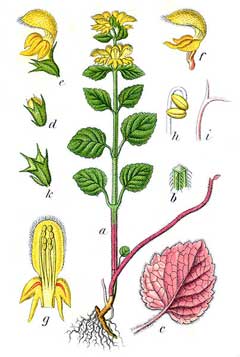
Yellow Archangel
Latin Name: Lamium galeobdolon
USDA Hardiness: 3-9
Native Range: TEMPERATE ASIA: Iran (north), Turkey (north), Azerbaijan, Georgia EUROPE: Denmark, Finland (south), United Kingdom (England (east)), Sweden (south), Czechoslovakia, Austria, Switzerland, Germany, Hungary, Netherlands, Poland, Russian Federation (European part), Belarus, Estonia, Lithuania, Latvia, Ukraine, Former Yugoslavia, Albania, Bulgaria, Greece (north), Italy, Romania, Spain (north), France
Edibility Rating: 2 / 5
Medicinal Rating: 1 / 5
Region:
Family:
Plant Type:
Medicinal Uses
Edible Uses
Edible Parts: Flowers Leaves Shoots | Edible Uses: Young leaves and shoots - cooked[183]. Young flowering tips - cooked.
Cultivation
Landscape Uses:Ground cover, Massing, Woodland garden. A very easily grown plant, it tolerates most soils and conditions[200]. It grows well in heavy clay soils[17], though it prefers a light calcareous soil[1]. Dislikes dry soils[31]. This species succeeds even in dense shade, growing well under trees[31, 200]. Once established, it can also succeed in drought conditions under the shade of trees, providing there is plenty of humus in the soil[190]. There are at least four sub-species, L. galeobdolon montanum is the form generally found wild in Britain and it is a triploid. L. galeobdolon luteum and L. galeobdolon flavidum are both diploids[187]. L. galeobdolon argentatum is the more rampant form, its clone 'Variegatum' is a commonly used ground cover plant for shady places[187]. Plants seem to be immune to the predations of rabbits[233]. A very invasive plant, sending out long prostrate shoots that root at intervals along the stems[31, 200]. Special Features: Attractive foliage, Naturalizing. In garden design, as well as the above-ground architecture of a plant, root structure considerations help in choosing plants that work together for their optimal soil requirements including nutrients and water. The root pattern is rhizomatous with underground stems sending roots and shoots along their length [2-1].
Known Hazards
None known
Habitats
Woods and shady hedgerows[5, 31], usually on heavier soils. Sometimes becoming locally dominant, especially after coppicing[17].
